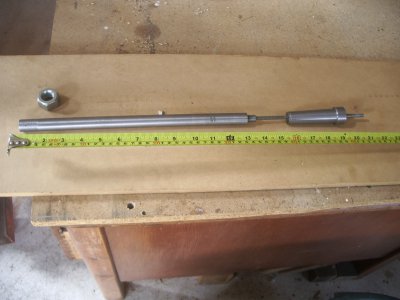Good Morning,
Was wondering how does a machinist decide what tpi thread to use for a particular job.
Currently in my head I see things as follows
Fine threads - used for both measuring tools and fastening i.e. at 40tpi 1 full turn = 25 thousandths so fairly easy to graduate a dial into thousandths when screwed onto a 40 tpi thread
Fine threads - also used when a thin bolt is needed, intuition and common sense indicates that a 10 tpi thread on a 1/8" diameter bolt is just not going to work
Coarse threads - used for fastening rather than measuring and used on thicker stock - i.e. 10 tpi on a 1" diameter bolt seems ok to me. It would takes aaaaages to tighten up big 2" diameter bolts holding an iron bridge together at 40 tpi.
And there must be some sort of grey area "in between"
The reason I ask is that I have made a drawbar for a chuck backstop and I noticed that in George Thomas book he recommended 32 tpi thread at the back end. See photo. I get the impression George Thomas was a perfectionist and paid great attention to tiny details.
My drawbar is 0.740" diameter and this seems to be exactly right to cut 10tpi and I just happen to have a spare 10pi nut just sitting around doing nothing.
At 32tpi would there be a lot more contact area therefore more friction therefore lower probability of any vibration loosening the thread ?
Pondering on these things makes me ask the following questions -
Any good web sites / previous threads / books that cover the logic behind the tpi and tooth depth for a threaded bar i.e. any thumb rules - for example, tooth depth must be <10% of stock diameter ?
For a secure nut on a drawbar would you go for more rather than less tpi ? Given the time I've put in so far I dont want to ruin this backstop at the last minute.
Bill

Was wondering how does a machinist decide what tpi thread to use for a particular job.
Currently in my head I see things as follows
Fine threads - used for both measuring tools and fastening i.e. at 40tpi 1 full turn = 25 thousandths so fairly easy to graduate a dial into thousandths when screwed onto a 40 tpi thread
Fine threads - also used when a thin bolt is needed, intuition and common sense indicates that a 10 tpi thread on a 1/8" diameter bolt is just not going to work
Coarse threads - used for fastening rather than measuring and used on thicker stock - i.e. 10 tpi on a 1" diameter bolt seems ok to me. It would takes aaaaages to tighten up big 2" diameter bolts holding an iron bridge together at 40 tpi.
And there must be some sort of grey area "in between"
The reason I ask is that I have made a drawbar for a chuck backstop and I noticed that in George Thomas book he recommended 32 tpi thread at the back end. See photo. I get the impression George Thomas was a perfectionist and paid great attention to tiny details.
My drawbar is 0.740" diameter and this seems to be exactly right to cut 10tpi and I just happen to have a spare 10pi nut just sitting around doing nothing.
At 32tpi would there be a lot more contact area therefore more friction therefore lower probability of any vibration loosening the thread ?
Pondering on these things makes me ask the following questions -
Any good web sites / previous threads / books that cover the logic behind the tpi and tooth depth for a threaded bar i.e. any thumb rules - for example, tooth depth must be <10% of stock diameter ?
For a secure nut on a drawbar would you go for more rather than less tpi ? Given the time I've put in so far I dont want to ruin this backstop at the last minute.
Bill


